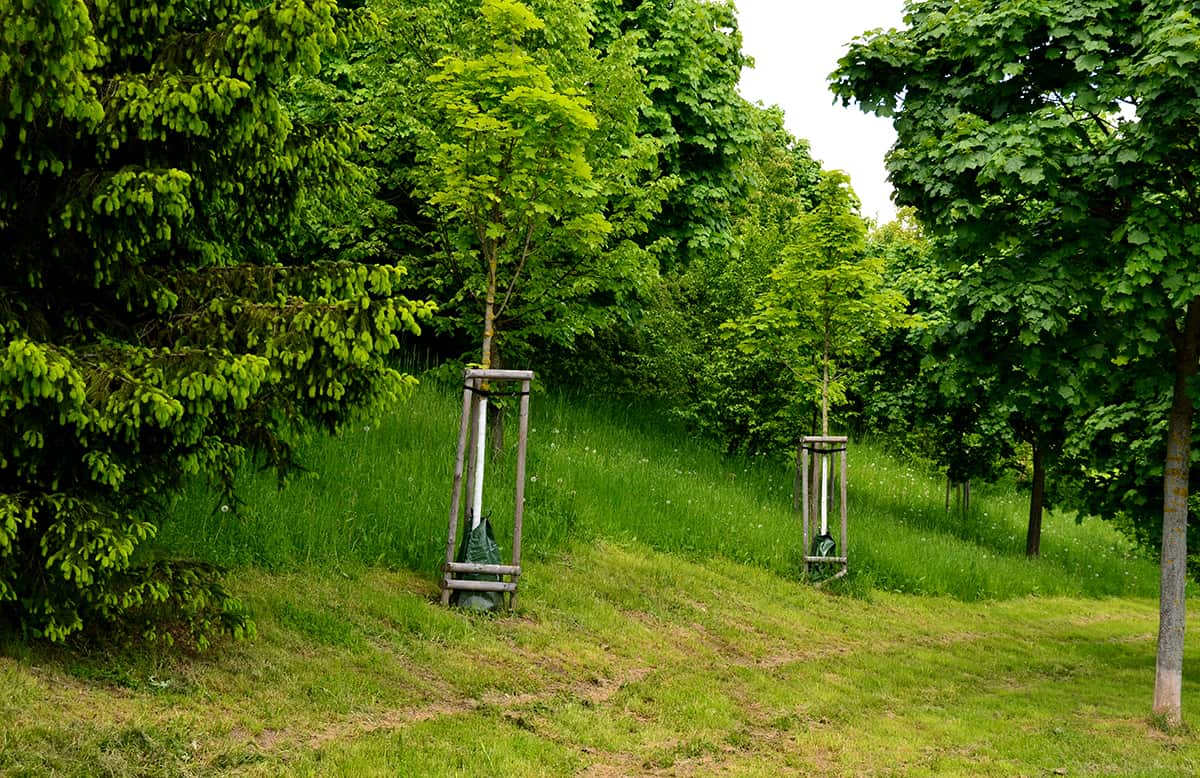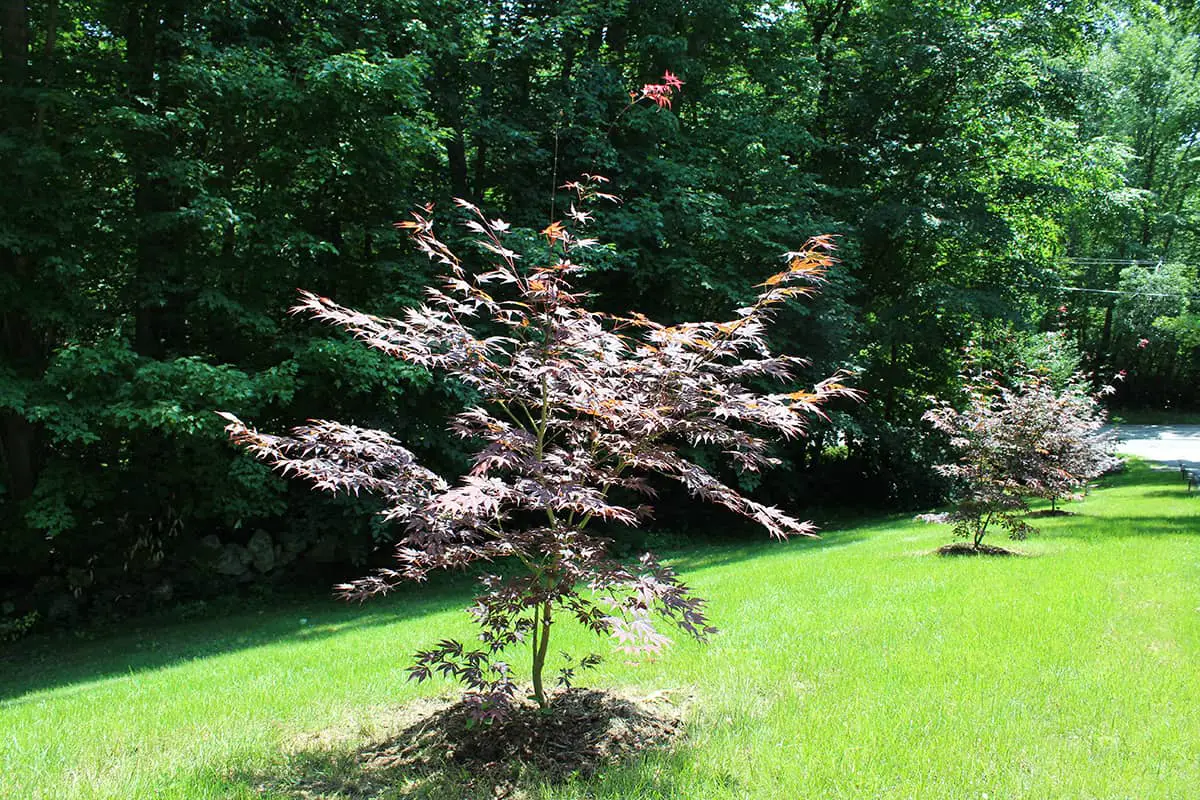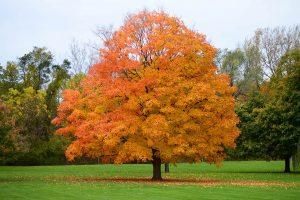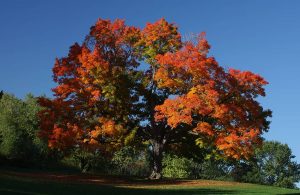Maple trees belong to the Acer genus, and within this genus, there are over 130 different species. Maple trees range in size from just a few feet tall to over 150 feet, depending on the species of the tree.
This means that the spacing you need to allow between maple trees is heavily dependent on which type of maple you have. Smaller maple trees, like most notably Japanese Maples (Acer palmatum), can be planted as close as 5 feet from one another. For larger types of maple trees, such as the Sugar Maple (Acer saccharum), as much as 50 feet between each tree may be necessary for optimum growth.
Table of Contents
Maple Tree Planting Distance
The planting distance between maple trees will affect the way they grow. When trees are planted close together, they will grow taller rather than wider, expending their energy on growing upwards instead of sideways. This will result in a more forest-style space, where the canopy is a long distance from the ground, and the branches of the trees slightly merge together to create a more dense shade. When trees are planted further apart, they will generally have lower canopies.
The distance at which you plant your maple trees from each other will need to factor in the way you want them to grow, as well as other considerations we explore below. In most cases, basing your planting distance on the expected canopy spread works best. For a maple tree with an expected spread of 30 to 50 feet, you can plant the trees 25 or 30 feet apart from each other for forest-style growth or as much as 50 feet apart from each other if you want them to be able to spread to their full potential.
Invasive roots can be a problem with maple trees, for example in the case of the Silver Maple (Acer saccharinum). The roots of these trees have been known to dominate the soil in some regions, which can strangle out the roots of other nearby plants. If you are planting a type of maple which is invasive, then creating a greater distance between that tree and other nearby plants and trees will be beneficial.
For Silver Maples, the expected spread of the canopy is around 40 feet, so a minimum distance of 40 feet between each tree will be best. If you are unsure whether a species of maple is considered invasive in your region, a quick search engine query should tell you all you need to know, If you want to avoid invasive roots becoming an issue in your garden, it is best to stick with native plants which are well adapted to the environment and to other native plants, allowing them to all thrive in harmony together in the same space.
Planting Distance Considerations

When assessing how far apart to space your maple trees, there are a number of things to consider. Here we look at the main factors that will affect your planting distances when it comes to growing maple trees for ornamental value, as well as commercial value.
Root spread
When planting any type of tree, you’ll need to think about how far and wide the roots of the tree are going to spread. For maple trees, the root spread will typically be similar to the spread of their canopy above ground, give or take a few feet. Although trees can share the soil beneath them with the roots of other plants, when trees are placed too close together, they can suffer from a nutrient deficiency or a lack of moisture if the roots from other nearby plants dominate the soil.
Since many maple trees thrive in soils that are consistently moist and high in nitrogen, it’s a bad idea to plant the trees so close together that they will be competing for water and nutrients.
If you’re planting maple trees near a structure, such as a fence or a house, then you’ll also want to consider whether the roots will become a problem for that structure. In general, maple tree roots are not known for being destructive. However, it is most sensible to plant them at least 6 feet away from any fences or underground pipes and 8 feet away from paths or driveways. A greater distance is best when it comes to buildings and septic systems, with a minimum distance of 15 feet being recommended.
Canopy spread
The canopy spread of a maple tree should be considered when planting it alongside other maple trees because you may not want the canopy of one tree restricting the canopy growth of another. In many types of maple species, the expected canopy spread can be as much as the expected height growth.
For the larger maple trees, the expected canopy spread or width spread can be in excess of 80 feet. If you want your maple trees to be able to spread and reach their potential size, then you should plant them far enough apart from each other that their canopies aren’t going to cross paths.
This means that for a maple tree with an expected spread of 50 feet, you should plant the next closest maple at a distance of 50 feet, from trunk to trunk. However, if you’re looking for more of a forest feel, with an overhead canopy that provides a lot of shade, then you can plant maple trees closer together. This will allow their canopies to merge together somewhat, though it can restrict the spread of a tree.
Tree purpose
The function of your tree can heavily influence how far apart maples need to be spaced. If you are planting maple trees for ornamental value, then you can alter your spacing distance depending on your desired look. For example, for a dense shady area or a forest-style look, the trees can be planted closer together, or to make a statement out of each individual maple tree, they should be planted further apart.
If you are growing maple trees for commercial reasons, then this will largely dictate what space you should allow between each tree. Sugar Maple trees which are being grown for their maple syrup, should be allowed plenty of space for their canopies to spread out. This is because trees that are grown in wide open spaces are known to produce greater amounts of sap, therefore making them more productive and valuable.
Since Sugar Maple trees reach a typical spread of between 30 and 50 feet, a distance of 30 feet is recommended between each tree. This strikes a good balance between letting the tree have room to grow while being conscious of not wasting growing room on the land where more trees could be planted.
If maple trees are being grown for their lumber, then planting them closer together is actually more beneficial. This is because when the trees are grown in a more tightly packed environment, the branches are encouraged to fork, which will result in thicker and denser branches. These branches will be much more suitable for being used as wood compared with long and scrawny branches. When planting maple trees for producing lumber, they can be grown as little as 14 feet apart.




